Review: Nokia Lumia 630
When launched a few months ago, we described the WP8.1-running Lumia 630 as 'the high point of the low end' in terms of positioning. As pricing is turning out in the UK, it's now available from under £10 a month on contract and under £100 on pay-as-you-go, making the 630 a firm contender for a budget/first smartphone and following on from last year's 520 and 620. It's solid, it's extremely functional and most (though not all) of the compromises needed to get down to this price seem to have been justified.

Of course, there may yet be a Lumia 530, an even lower priced Windows Phone 8.1 device, but it'll have to be rock bottom to get under the 630 - you could even argue that a 530 isn't even needed anymore. And, after all what else could you cut out, short of making the phone smaller?
The Lumia 630, launched at BUILD 2014, is available as here in single-SIM form and various shell colours, plus a dual SIM option in some countries. It's distinguished from the slightly pricier 635 (again, in certain markets), which has LTE (4G), though for the 630's target market, 4G is all but irrelevant, since data speed requirements will be relatively low.
Here's a table comparing the various low end Lumias, along with a few at the higher end:

Hardware
First impressions of the Lumia 630 are terrific - it's light, textured and grippy, with nicely angled sides. The latter is important, as the previous design language, used on the 520 and many other Lumias, used sides that curved away onto the back (the 'pudding' shape) and caused the phones to be immensely droppable. Both shape and texture solve this issue on the 630. Moreover the weight is low too, especially compared to many competitors from the Android world, causing those I handed the 630 to comment on this factor.

The concept is the same, mind you, the back/sides/shell pop off, revealing a 1830mAh replaceable battery (vital at the low end of the market, where phones are expected to do duty in the family for years) and.... very little else. There are slots to insert a micro SIM and microSD card, but that's your lot. No Qi charging at this price point, no battery contacts for adding a wireless charging shell, no NFC aerial, and so on. We're talking strict no frills here. Battery life isn't brilliant, but then, as those following my trials of the 8.1 Developer Preview will know, battery useage is still being optimised in the OS and we all expect more in future updates.
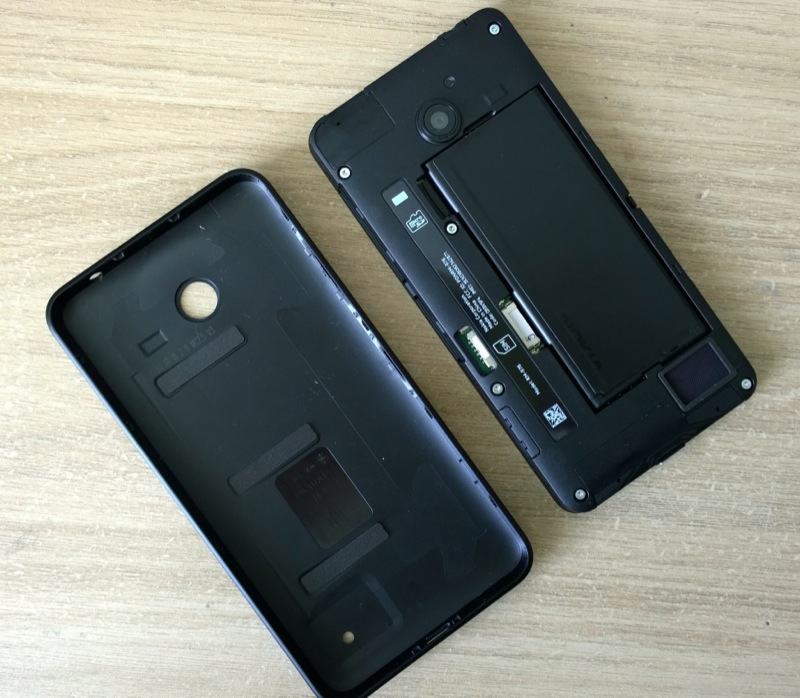
The back clips on and off smartly enough, with just enough bend to allow easy removal when needed and just enough grip points to stay on however it's handled. There's no attempt at waterproofing, though as with most Nokias with removeable batteries, if the phone gets accidentally dunked then it's an easy matter to whip out the battery and SIM card and let it all dry out. Reassembled, it should work fine.

A largish speaker cavity built into the 630's frame pumps out a loud (but understandably tinny, at this price point) sound through a small hole in the back cover, while the 5MP camera is raised imperceptibly over the rest of the material. I honestly doubt that it needs to be raised at all, but there's a certain design theme here that goes all the way up to the likes of the 925 and 1520, so why not?

The side buttons are really well done, rectangular and shaped/themed to fit in with the angled sides. Moving round the front reveals perhaps the single biggest price compromise for the Lumia 630 - the display. Now, don't get me wrong, it's still decent and fits in well at the £100 handset price point, but if you're expecting a 5" display as on flagships of this size in the phone world then you'll be disappointed. A 4.5" LCD screen has over 1cm of bezel above and below it, plus you also lose 7mm or so in almost all applications for the virtual control icons for Windows Phone 8.1 - and it doesn't seem at this point in time that they can be swiped out of the way. Maybe this will come in a future platform update?

Allowing for the virtual controls, you end up with a 4.25" diagonal screen, though in fairness this is still larger than the Lumia 520's display from last year and the price points aren't that different. Visibility outdoors is typically low end, Nokia claim 'ClearBlack Display' branding, but in truth it's no more than a simple linear lamination:
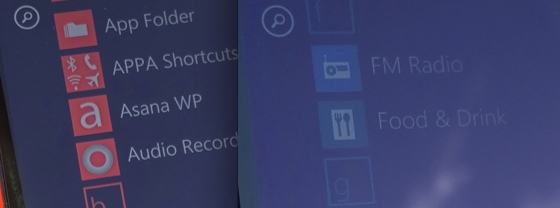
Outdoors in oblique sunlight, similar screen fragments at the same angle from the CBD-equipped Lumia 920 (left) and the 'CBD' laminated Lumia 630 (right)
Resolution is 480x854, so WVGA, which looks a little pixellated to those used to higher end phones, but which is quite acceptable to the target market here - the moment a user starts to talk about pixellation and PPI then they're automatically in the market for something better! Plus the 630 screen is full RGB, as usual with all recent Nokias - whereas quite a bit of the Android competition may boast higher nominal resolution but actually use a 'pentile' screen, effectively/arguably halving the 'actual' resolution.
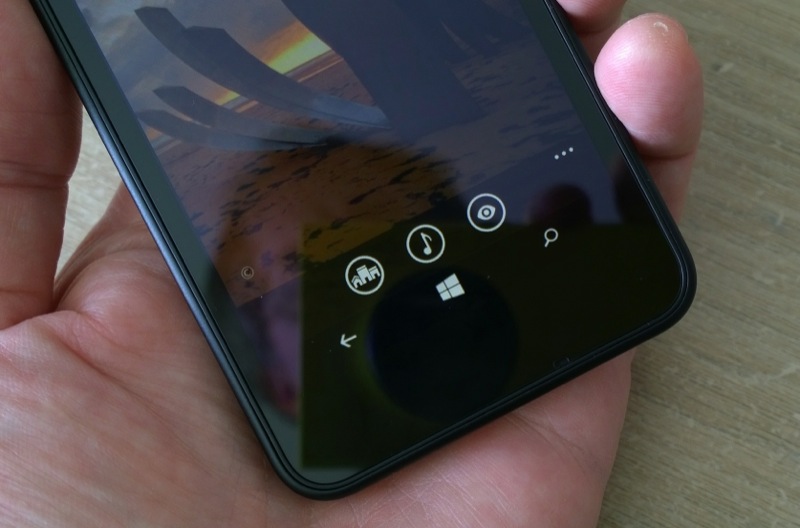
Rather curiously, there's no auto-brightness setting in the software, from which I can conclude that money has also been saved in not including a light sensor above the screen. This is a curious omission, since such a sensor is on just about every other phone in the world, but then again auto-brightness can also be a pain - here a simple 'low/medium/high' switch suffices. I'd declare this as an issue, but I note that one of the (configurable) Windows Phone 8.1 quick setting panels in the drop down Action Center lets you toggle the current brightness, so it really does only take a second or two to change the current level if needed.
Also missing is any kind of coating for the Gorilla Glass 3 - this may sound like a little thing, but the Lumia 630's display is an utter fingerprint magnet - within half an hour of cleaning, it'll be covered in the things. Presumably an oleophobic coating would have pushed up the bill of materials again? In fairness, you can't see the prints when the screen is turned on and most people don't seem too bothered by them - maybe it's just me...?

Even more curiously, money has been saved by not including a front facing camera (i.e. towards the user). While many other sub-£100 smartphones also lack this, it seems odd to miss this here, given the focus on Skype in Windows Phone - having this integrated into the OS (well, almost integrated - at least it's preinstalled - Microsoft has been working on this for years, I know....!) is on the potential highlights and differentiators of the platform. Not being able to do video calls over Skype - or easy selfies - is disappointing, especially as this is exactly the sort of thing I'd expect the target market to want to try out.
The 5MP stills camera here isn't stellar, as you might expect, with plenty of sharpening artefacts, poor low light performance, no LED flash and very 'average' results all round. But again, par for the course at this price point. Here are a few of my better samples taken on the Lumia 630, click any of them to download the full 5MP version:
Video capture is also mediocre, topping out at 720p, though given the screen's lower resolution, this is absolutely fine for the target market's expectations (i.e. watching back on the phone screen) and it's fine for 'social' video clips.
Inside the Lumia 630, the speed of the device is masked as usual by the enforced transitions, but it seems as speedy as any other Windows Phone device. The Snapdragon 400 processor is backed up by 512MB of RAM. Hardly cutting edge, but perfectly fine for the target market apart from certain games which demand 1GB of RAM (and therefore shouldn't be shown in the Store on this device in the first place). 8GB of on-device storage has been the minimum spec for a couple of years, especially as you only get about 4GB free out of the box.
There's the microSD card, of course, and with Windows Phone 8.1 it's possible to move applications, media and downloads from the internal storage to card - and to set the card as the default for everything in the first place. There's no way to get at the card while the phone is powered on, of course, so there's no chance of yanking out a card hosting an application that's being used, and thus corrupting the file system. Microsoft has thought all of this out quite well and it's now the pick of the current mobile OS in terms of flexibility of this kind.
Plus, as with any phone linked to a Microsoft account, you get a certain amount of free cloud storage in OneDrive (previously 'SkyDrive'), currently 10GB per account - this is integrated well into many built-in applications, though third party apps are still being tweaked for the Windows Phone 8.1 APIs and so not many are OneDrive-enabled as I write this.
Software
Windows Phone 8.1 has been covered here in detail a number of times, of course, so it's a known quantity, though the Lumia 630 does have the distinction of being the first smartphone to ship with it on, out of the box, plus, in theory, the first to ship with elements of the Lumia Cyan update, though most modules I looked at were identical to those in my 1020 running Lumia Black and the 8.1 Developer Preview, so I'm sure there are Cyan applications and modules which will arrive in due course in an update.
The virtual controls are primitive (by competing Android standards), in that they don't intelligently get out of the way when watching a movie, browsing a web page or viewing a photo (and so on). In fact, worse than this, the controls sometimes hide part of the content, as I discovered when watching sideloaded movies (shown below)! The whole point of virtual controls is that they're flexible enough to be essentially invisible (or removeable) when needed, in order to free up the whole display.
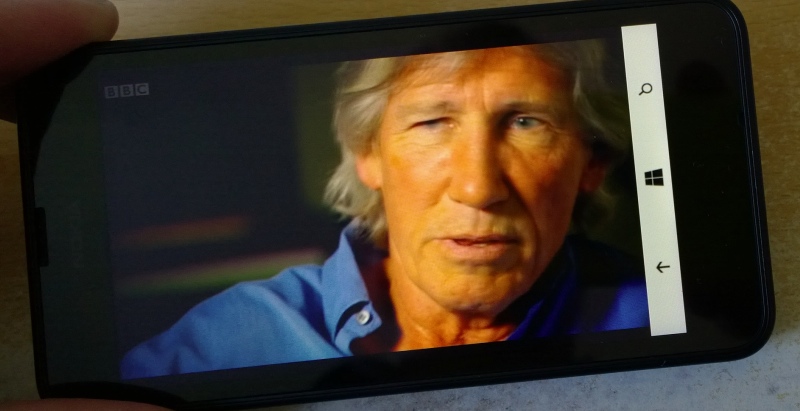
The right hand 8% (or so) of the picture is missing, hidden behind the stubborn navigation bar!
Which leads me to conclude that the Lumia 630 launch firmware is, again, not finished and that an update will follow in due course, to correct this sort of thing. Plus, there are other glitches and oddities here and there. For example, in the Nokia Camera application, the 'flash' control icon is shown, even though the 630 doesn't have a flash.
The swipe down Action Center and notifications, plus the extended Start screen tile options are also well known, the former making a huge difference, especially when a new user might not have fine tuned their Start screen as well as a power user might, so the appropriate notifications could otherwise go unnoticed. Of course, the user needs to know to swipe down to get Action Center in the first place, but at least that kind of action is becoming commonplace these days, being used in similar fashion on iPhones and on Android.
The 'swipe left' application list is notable here in that it's alpha-divided from the get go, i.e. new users no longer have to wait until they amass enough applications before the alphabetic letter dividers kick in. In practice, tapping on any letter to get the full A-Z list is something I do many times a day and is a really intuitive way to get to applications that aren't already pinned to the Start screen.
'Motion data' is another addition of note to the Lumia 630's Settings hierarchy, tying into the 'SensorCore' system, a low power motion-sensing chip which can be accessed by third party applications using Nokia/Microsoft's SensorCore APIs. The obvious use for this is in sports and health applications, though we've yet to see many developers finish SensorCore-compatible apps.


One possibly significant change from last year's budget Lumias is that the HERE Maps/Drive systems have been expanded to cover the whole world with full functionality. Presumably this is Microsoft's licensing of all the data needed from Nokia's HERE, but it's a nice touch for any Lumia 630 owners planning to travel.
Overall, the Windows Phone out-of-the-box software package is pretty unbeatable in the mobile world - with the media apps like MixRadio, the gaming integration of Xbox, the offline worldwide voice navigation and the Office/OneNote applications, all built-in and ready to go, the new user at least starts with an awful lot of the basics.
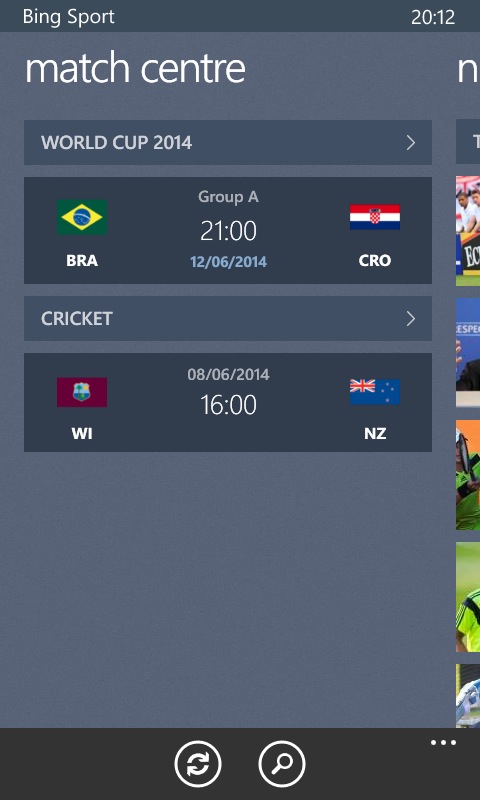
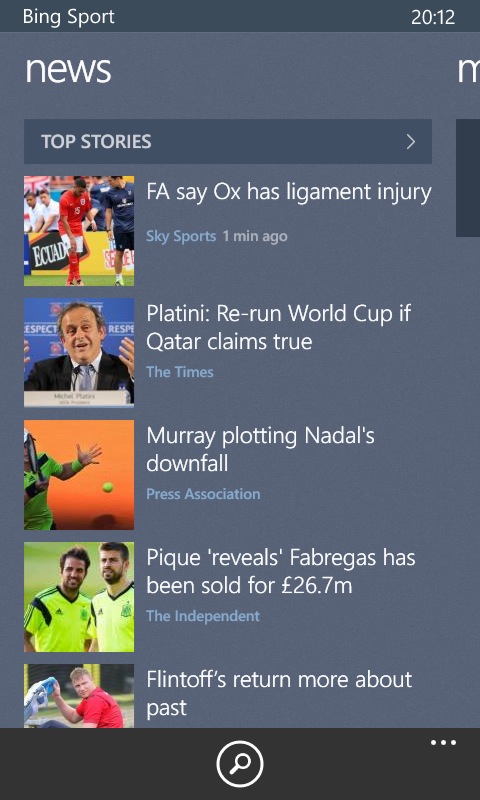
Plus the app set has expanded further in the last year or so, with the Bing Weather and Bing Sport applications not only included but pinned to the Start screen (with the latter's icon currently set to the World Cup, rather topically!). Then, when the time is right (at least for those outside the USA), Cortana will be released and set to the virtual Search control, at which point the app set will leap ahead again.
It's fair to say that boutique/niche applications (or, indeed, anything from Google - sigh) are thin on the ground in the Windows Phone Store, but this is an issue which has been much discussed elsewhere and I've a feeling that quite a bit of this ground will be made up in 2014 as the iOS and Android worlds become saturated (for developers). Let's stay optimistic here.
Verdict
Reviewed here is the black Lumia 630, but note that green, orange, yellow and white also exist, at least as shells, with the front fascia remaining black throughout. The various colours may well, in some markets, be carrier-specific.
Possibly the most telling comment about this device came from my wife (she's used to iOS) - who took to the Lumia 630 instantly, proclaiming after 15 minutes with it "This is my kind of phone!", she loved the size, weight, speed of the interface and - yes - the world cup info linked from the Start screen. Windows Phone's attraction for new (and less affluent) smartphone users remains as strong as ever - at least, potentially, until a particular application is found to be not available(!) - and the Lumia 630 perhaps personifies this in 2014 budget form.
Yes, looking at the 630 with an experienced eye, one that's used to playing with the 1020, 1520, 925, and so on, all of which are probably running the 8.1 Developer Preview in most AAWP users' hands, the display, camera and lack of gadgets are going to disappoint. But this is a different smartphone for a different market and, just as the 520 before it (and until a 530 arrives to challenge it), the Lumia 630 should sell very well indeed in Europe.
Reviewed by Steve Litchfield at




